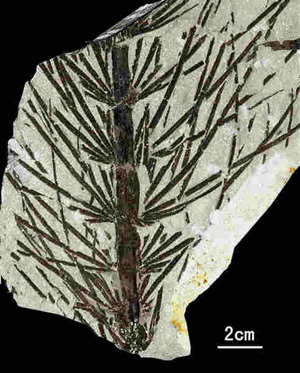
The fossilized leaves and stem of Asterophyllites, an extinct species of plant, found in Wuda. Provided to China Daily
Significant find
A city with a dry and windy climate, Wuhai - comprising three districts, including Wuda - lies only kilometers away from the desert. It is so different from what it was 298 million years ago, when the area was a river delta in a tropical zone.
Back then, North and South China appeared as two large islands, respectively, in a tropical ocean, and North America and Europe were fused together.
"It was a catastrophe going back 298 million years ago in Wuda," said Wang. A sudden volcano erupted more than 100 kilometers away from the forest, killing all the plants nearby.
But the locals just took the rich abundance of fossils in the area for granted.
"We just noticed there was a large quantity of them and never bothered to learn where they came from," said Jia Yueyong, who has worked at the Wuda coal field for more than 30 years. He did not realize how extraordinary the fossils buried between the coal beds were until March, when Wang's findings received intensive media coverage.
"We used to sell the rocks to a ceramics factory," Jia said.
The value of the fossils would probably never have been uncovered had Wang's tutor not introduced him to the city.
"I was doing my postdoctoral research on fossilized Noeggerathiales, a now-extinct order of vascular plants, but the only specimen I had was a tiny one provided by my tutor," he said.
Wang's research needed many more specimens than one, and his tutor told him the specimen was found in Wuda. That was how he came to make his first visit to the city in 1999.
Wang was soon stunned by the abundant supply of fossils in the coal mine in Wuda, and since then, he has visited the city for fossils each year.
However, it took until 2003 for Wang and Hermann Pfefferkorn, a paleobotanist from the University of Pennsylvania, to discover that the fossils were no ordinary specimens.
"We found that there were upright trunks in one rock layer between two coal seams, an indicator that those plants had not been transported by water or wind when they were fossilized, as most plants would," Wang said. "So we cut the rock samples and checked under the microscope, and found it was volcanic ash originally."
Together they determined that an area as large as 20 square kilometers of volcanic tuff bed existed between the coal seams.
The discovery was only a minor step toward the reconstruction of the ancient forest, which would require the removal of all the earth and coal atop the volcanic ash-fall tuff.
The intensive open-pit mining in the coal mine between 2006 and 2008 made what seemed impossible possible.
Wang worked with miners and digger operators, who removed the coal beds and earth atop the rock layer in which the fossils were distributed and then closely examined the rocks for samples.
In Wuda, years of open-pit mining had shifted the landscape in the coal mine area, leaving a shattered landscape and piles of sand and rocks that had been dug out.
Wang said he was extremely grateful to Zhang Haiwang, an official from the coal mining safety authority of the autonomous region, who offered him help and enabled the miners to cooperate with him. In particular, the cooperation gave him two weeks of precious time to conduct his research before the miners removed everything.
For years, a minibus shuttled Wang and his fellow researchers along extremely uneven roads between coal piles and earth dumps of Wuda coal mine.
Despite harsh weather conditions, Wang stuck to the same routine at the coal mine with his team: Hammering stones and examining each piece for fossils.
Then his team would use hammers to closely examine the rocks for samples and record the exact location of where each sample was found. Then they identified what kind of tree the samples belonged to.
After examining the trees distributed in each square meter in three areas totaling more than 1,000 square meters, the researchers worked with painter Ren Yugao to depict what each tree was like in these locations.
It took Ren two years to finish the depiction of the ancient forest before it was published in the US academic journal.
"We worked closely on details of how the trees should appear in the picture. Sometimes I had to take Ren to botanical gardens to give him an idea," Wang said.

Copyright ©1999-2011 Chinanews.com. All rights reserved.
Reproduction in whole or in part without permission is prohibited.